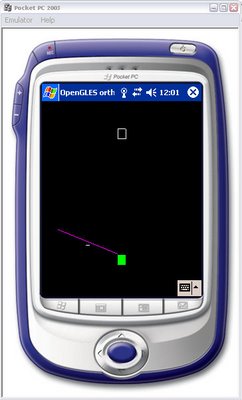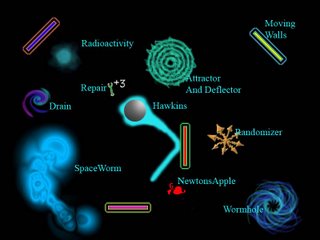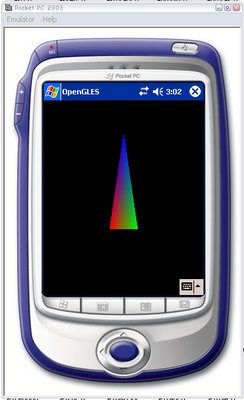THE GAME IN BRIEF
Its a mobile game. Specially designed for smart phones or PDAâs. Where player has to control a continuously moving ball with the help of a bar, that he can draw on the mobile screen using pen. That bar will act as a barrier on the way of moving ball. And the ball will rebound after striking the bar. The target of the player is to not to allow the ball to hit the boundries of the screen and in addition to that he has to make the ball to hit specific items moving in space to earn points and some strengths and also he has to avoid some items in space that can result in death or loss of points for the player. So ultimately the goal of the player is to stay alive as long as he can and cover more and more stages, to get maximim points.
"Hawkins Wormhole" - narrative
You are Steven Hawkins and you are traveling through universe with a spherical time capsule. Your mission given to you by the Royal Science Academy is to collect Newtons "apples" that has been spread out in the universe by the big bang. When you have collected enough of apples in one area a wormhole will form as a space worm appears. The space worm wants to eat your apples. The only possibility for you to keep the apples is now to escape through the worm hole or else be eaten by the space wormâ¦
Saturday, April 29, 2006
glFixed
Although some embedded systems provide native support for floating point values, most
do not, especially cell phones, where the power requirements for an FPU are too high.
However, noninteger values are critical to 3D graphics, so OpenGL ES provides the option
for implementations to support them via the OES_ fixed_ point core addition.
This extension adds a number of things to OpenGL ES. First, it adds two new types,
GLfixed and GLclampx. These types are effectively 32 bit integers treated as fixed point value
in an S15.16 format (see Chapter 4 for a detailed discussion of fixed point math).
Second, the glVertexPointer() , glColorPointer() , glNormalPointer() , and glTexCoordPointer()
functions are extended to accept GL_ FIXED as the type parameter, indicating an array of
type GLfixed.
Finally, functions that accept GLfloat or GLdouble parameters are modified to accept
GLfixed instead. These functions are suffixed with an “x”, even if the original function was
not suffixed with an “f” or “d”. A complete list of these functions is shown in Table 3.16.
Astle, Dave. OpenGL ES Game Development.
Boston, MA, USA: Course Technology, 2004. p 59.
http://site.ebrary.com.lt.ltag.bibl.liu.se/lib/linkoping/Doc?id=10065762&ppg=81
Copyright © 2004. Course Technology. All rights reserved.
Function
void glNormal3x (GLfixed nx, GLfixed ny, GLfixed nz);
void glMultiTexCoord4x( GLenum texture, GLfixed s, GLfixed t, GLfixed r, GLfixed q);
void glColor4x( GLfixed r, GLfixed g, GLfixed b, GLfixed a);
void glDepthRangex( GLclampx n, GLclampx f);
void glLoadMatrixx( const GLfixed m[ 16]);
void glMultMatrixx( const GLfixed m[ 16]);
void glRotatex( GLfixed angle, GLfixed x, GLfixed y, GLfixed z);
void glScalex( GLfixed x, GLfixed y, GLfixed z);
void glTranslatex( GLfixed x, GLfixed y, GLfixed z);
void glFrustumx( GLfixed l, GLfixed r, GLfixed b, GLfixed t, GLfixed n, GLfixed f);
void glOrthox( GLfixed l, GLfixed r, GLfixed b, GLfixed t, GLfixed n, GLfixed f);
void glMaterialx[ v]( GLenum face, GLenum pname, GLfixed param);
void glLightx[ v]( GLenum light, GLenum pname, GLfixed * params);
void glLightModelx[ v]( GLenum pname, GLfixed param);
void glPointSizex( GLfixed size);
void glLineWidthx( GLfixed width);
void glPolygonOffsetx( GLfixed factor, GLfixed units);
void glTexParameterx[ v]( GLenum target, GLenum pname, GLfixed param);
void glTexEnvx[ v]( GLenum target, GLenum pname, GLfixed param);
void glFogx[ v]( GLenum pname, GLfixed param);
void glSampleCoverage( GLclampx value, GLboolean invert);
void glAlphaFuncx( GLenum func, GLclampx ref);
void glClearColorx( GLclampx red, GLclampx green, GLclampx blue, GLclampx alpha);
void glClearDepthx( GLclampx depth);
Astle, Dave. OpenGL ES Game Development.
Boston, MA, USA: Course Technology, 2004. p 60.
http://site.ebrary.com.lt.ltag.bibl.liu.se/lib/linkoping/Doc?id=10065762&ppg=82
Copyright © 2004. Course Technology. All rights reserved.
Friday, April 28, 2006
update..

So far this is how it looks. The red line is the paddle and orients itself with the movement of the mouse. The position and orientation of the paddle can be changed. The white box is the ball and moves with a constant speed. I am now working on the collision with the ball and the paddle. After that we load some texture and make it look cool and nice.
Thursday, April 27, 2006
console
OpenGL ES Transformation Functions
Geometric Spectification Functions
Sunday, April 23, 2006
how to fix pocket pc emulator disabled error..
- right click on my computer and select properties.
- select advanced tab
- select settings in startup and recovery section
- selct edit to edit boot.ini file
- change /noexecute=optin to /execute=optin
Friday, April 21, 2006
the game design v0.1

Radioactivity – number of points is taken. Speed is decreased.
Rapair – number of point of damage repaired for each wrench appearing. Speed is increased.
Drain - when a Hawkins moves onto or over a drain, speed is decreased.
Spaceworm – Will hunt you and try to eat you, and it will compete for the Newtons apples. You have to be first or the worm will eat them.
Attractor & Deflector – Works in cycles. For one cycle is will attract you…. And if you are trapped you have to stay inside it until next cycle it will deflect you. If you were trapped in its last cycle it will repeal Hawkins in a random direction. If you were not trapped you will just be deflected.
Randomizer – Will repeal you in a random direction.
WormHole – will teleport you to a new level.
Newtons Apple – what will give you scoring marks and more speed.
Moving Walls – moving in the direction of the shortest side.
Hawkins – the player, this is you!
Tuesday, April 18, 2006
some ideas about details of the game
what i think is trying to make the screen neat, so the cell shading will look nice, with only black gray and white color.
but some special effect can have different color, when the planet get some gadget, there will some patical system effect with different color. just colors other than black and white should not be used frequently.
object:
planet or spaceship:
the object we are going to control
with some visual effect(partical system or with cell shading)
black hole:
if the planet touches the balck hole, the game fail.
appear randomly, but will not be within a certain distance.
the black hole has big gravity, and it will affect the path of the planet movement.
score object:
if the planet touched enouph score objects, the stage will be clear and go to next stage.
several gadget:
the gadget: affect the size, speed, shape, appearance of the ball
also the length of the line.
increase life
fixed star:
which is shining, that means when the planet is too close to the fixed star like sun, the planet will be very difficult to see, and player have to predict the path the planet will move
exam
BTW. That is some excellent work Ruman and Wang has put in already :D
Monday, April 17, 2006
Narrative
ruman
Won't run on pocket pc!?!?
Can't run the demo compiled codes on the pocket pc.
Cannot find 'tutorial1' (or one of its components). Make sure the path and filename are correct and all the required libraries are available.
I have all the required files on the same folder.. but still get the same error. I tried with different dll files and tried with both the release and debug exe files. Don't know what the problem is :(
Saturday, April 15, 2006
enviroment setting(opengl es)
2. install embedded visual c++ sp3
3. install pocket pc 2003 sdk
4. pocket pc 2003 second edition emulator
5. there are some samples
6. download vincent render library
7. copy GLES folder to following folders
C:\Program Files\Windows CE Tools\wce420\POCKET PC 2003\Include\Armv4
C:\Program Files\Windows CE Tools\wce420\POCKET PC 2003\Include\Emulator
8. copy dll file to the pocket pc emulator root directory, using [remote file viewer] in embedded visual c++.
book
Friday, April 14, 2006
Finally were able to compile some demo :D :D

After me and Wang working the whole morning.. installing so many things.. were finally able to run a demo code in an emulator :D.. for pocket pc 2003. Must say, the emulator is really slow. I will try to get hold of a real pda and try on it.
We compiled it in microsoft embedded visual c++ 4.0. The code we got from the tutorial site of typhoon labs: http://www.typhoonlabs.com/index.php?action=developer.htm
life of circles(narrative)
that game can present food chain in the wild life, the following is the stages that I think about:
human---->eagle----->snake------>mouse----->frog----->dragonfly----->mosquito------>humman
so each stage one is predator, but next stage the one will be eaten. then the game looks like a game with education for child.
the gadget in each stages will be different.
Thursday, April 13, 2006
Schedules..
- Game Concept Worksheet from each Group. Due April 28th
- Game Script from each Group. Due May 4th.
- Milestone Document from each Group. Due May 5th.
- Private Prototype Demonstration: May 18th, 2006.
- Game Project Presentations: June 1st. All day presentations
Somebody needs to update the blog with the outcome of yesterdays meeting. I suggest Zaheer do it as soon as possible before we start forgetting all about it..;)
Infos and tutorials..
I need a book.. does Mark have a book on OpenGL ES.. :)
OpenGL ES Game Development (Game Development Series)
Ruman
"Hawkins Wormhole" - narrative
Team members..
- Jimmy Esbjörnsson: jimes772@student.liu.se
- Ruman Zakaria: rumsa699@student.liu.se
- Sajjadul Islam: sajis997@student.liu.se
- Selva Ganesh: seldu153@student.liu.se
- Wang Chiyu: chiyuwang2004@gmail.com
- Zaheer Ahmed: zahch323@student.liu.se
Hellooo everybody
Ruman

